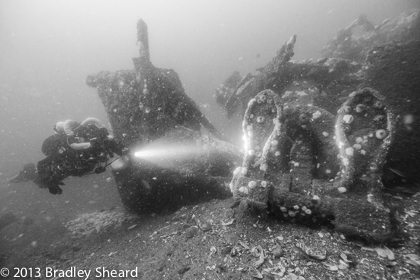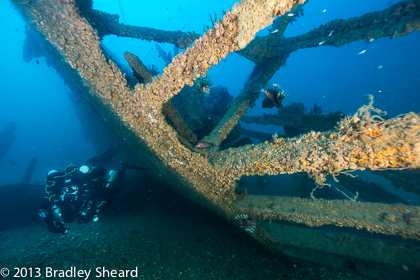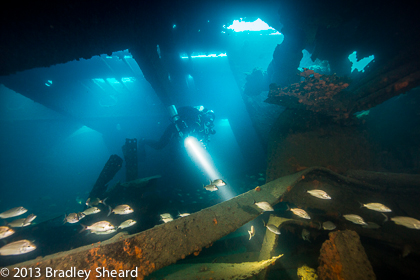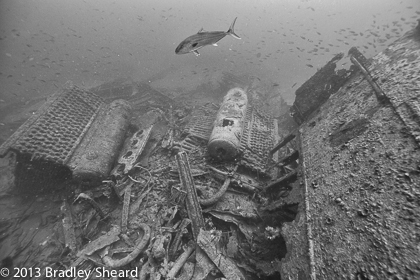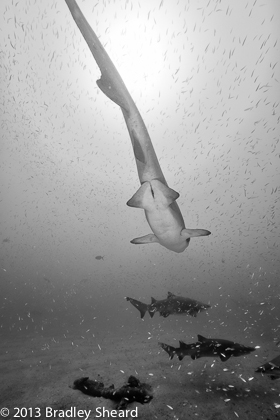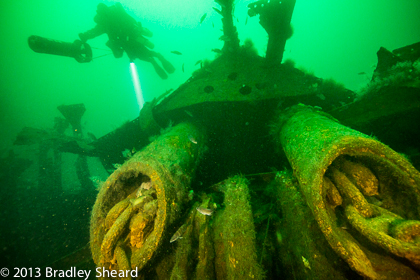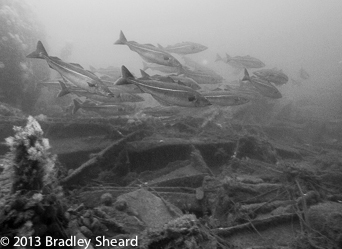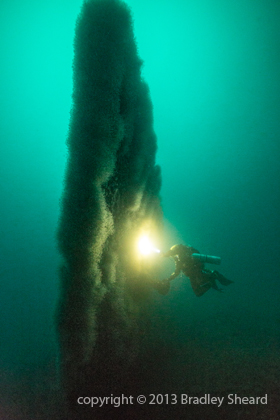 | | The image I had in my head for the past year: U-550 as seen head-on from the bow, with Mark Nix illuminating the wreck with a Light Monkey LED |
July 2013, Montauk NY: After a long winter of dreaming about this return trip to the U-boat we found last July, it's incredibly exciting to be in Montauk once again. We have been packing all our gear aboard Tenacious all afternoon and well into the evening. Tanks, rebreathers, scooters, cameras, food and water and anything else we might need offshore. It is a long 12-hour trip out to the wreck site--lots of time for multiple "day-dream-dives" to the wreck we all long to see again. On board are Joe Mazraani, Anthony Tedeschi, Tom Packer, Steve Gatto, Harold Moyers, Eric Takakjian, Mark Nix and myself.
For the past year I have had a specific image in my head. Ever since our discovery of, and dives to, U-550 last July, as well as Tom Packer's description of the submarine's bow, I have had a single objective for my return to the wreck. Picture the opening credit scene from the famous movie Das Boot: out of a dark green gloom, a shadow slowly emerges--a shadow that is headed directly toward you. Slowly it comes, growing steadily closer and gradually taking on form--a distinctive form clearly recognizable to any wreck diver: the bow-on view of a German U-boat. As it moves steadily closer it grows in size and height, grows until it is towering above you like a giant monolith. If you listen closely, you can surely hear that haunting music.....
That opening scene to one of the all-time classic World War II films is what I wanted to capture on "film." The only way to take the photo in my head, however, is by photographing with only ambient light--no strobes or artificial lighting can be expected to light up the entire bow of a U-boat! And the submarine is deep--100 meters down--so light levels are extremely low, pushing the limits of even cutting edge digital cameras. I learned this last year right here, shooting with a Canon 5D mark II camera: dialing up the ISO to 12,800 and shooting wide open at f/2.8, the images were still underexposed! I was able to process the raw files into useable images, but there was ample evidence of sensor noise and banding. Over the winter, I purchased a whole new camera system--a Canon 5D mark III and a new Aquatica housing. By my own tests in a darkened basement I determined that the new camera is 1-2 stops more sensitive to low light than the old, and I bought it with this very destination in mind.
Mark Nix volunteered to help me with my objective--and he had a scooter to boot! (I learned last year just how much drag carrying three stage bottles and a camera creates...) After our descent to the wreck, Mark towed me to the bow of the sub with his scooter, then posed next to the wreck. I dropped to the sand directly beneath and in front of the bow, while Mark moved from starboard to port, using his new Light Monkey LED to add accent lighting to the scene. It wasn't until then, standing on the bottom at 100 meters, that I fully came to appreciate how much rake there is to the bow of a U-boat--It was nearly impossible to get the whole thing in my viewfinder, even though I was using a 14mm lens! As Mark moved around the bow creating different compositions, I just kept banging away with my camera. The scene before me was so incredible that at one point I took my camera from my eye and shouted through my regulator, notionally to Mark, although I knew he couldn't hear me, "This is ____ awesome!" When we were done, Mark once again took me in tow, this time back to the anchor. We had a minute or two to bang out a couple quick shots of the conning tower, then it was time to head up to the surface. That image of the bow of U-550 will live in my memory forever....and many thanks to Mark for making it possible!
|

